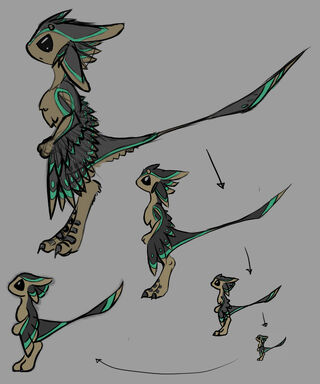A typical adult Avali stands around 3ft tall, and laid out, 5-6ft nose to tail tip (Of which half that length is a long, counterbalancing tail). Superficially resembling a cross between a large rabbit and a turkey, Avali stand bipedally, with digitigrade poise. They are covered from head to toe in feathers of varying length, possess two large wings with rudimentary digits at the wrist/hand enabling them to manipulate objects dexterously, while also possessing 4 long, rabbit-like ears.
Ammonia Biology

Unlike humans, the Avali rely on liquid ammonia as the primary solvent in their biology, which makes them extremely well adapted for cold environments, but renders Goldilocks worlds similar to Earth intolerably hot. It is important to note that the Avali are still carbon-based organisms; their systems merely use liquid ammonia instead of water.
In light of this, the Avali tend to require survival gear, cybernetics or EVA suits when exploring warmer worlds.
Physiology
Avali are not mammals, but instead more similar to prehistoric Earth dromaeosauridae. Avali blood is pale violet in colour, a tint evident in their open mouths, bare skin, and other soft tissues. Male and females are most easily told apart by their feathers, as there are no other external differences. Females tend to have muted, two-tone feathers, often with speckled patterns, while males have brightly coloured, iridescent bands across much of their body.
The Avali are superficially similar to dromaeosauridae of ancient Terra. They stand around 1 to 1.2 meters tall upright, around 1.5 to 1.8 meters from nose to tail tip, and are covered in a thick layer of insulating feathers. Their wing feathers allow them to glide extensively and even fly on their homeworld of Avalon, but are far less useful on higher-gravity worlds.
Similarly to Earth birds, the Avali possess an entire range of specialized feathers: their upper body has slicker and oilier feathers to protect from dry and abrasive snowstorms, while their lower body has lighter, fluffier down feathers that help to insulate the core body.
Their crest feathers (those on the head), respond well to the application of heat, causing them to curl towards the heat and become permanently deformed. In this way it is possible to "style" their crest feathers in a way analogous to hair styling.
The long feathers, such as those on the arms and crest, have a healthy blood supply at their roots and can bleed profusely if they are broken off or pulled out, though this does not pose a significant health risk. Feathers lost in that way will regrow after several weeks.
While the Avali possess large eyes, this is purely to provide some measure of eyesight in the very low light levels of their homeworld; their primary sense is hearing. Their four long, independently mobile ears can pick up sounds from multiple directions at once. Avali auditory processing is capable of tracking multiple sound sources simultaneously. This uncanny hearing gives the impression of blind sight, being able to "spot" and track creatures outside of line of sight. It also enables them to converse in parallel with their packmates, each member serving as a separate processor to find a resolution to the topic at hand.
Reproduction, Sexuality & Growth
Physiologically, both sexes of Avali are extremely similar; both possess a cloacal vent, and males lack the genitalia seen in terrestrial mammals. Instead, genetic material is passed the same way as seen in terrestrial birds.
After fertilization and a short internal gestation period, the female will lay a single large, soft, leathery egg. The amount of nutrients required for the production of an egg and eventually a baby makes large clutches impossible. Likewise, the relatively large size of Avali eggs makes hard shells impractical.
Eggs are left in the care of a communal hatchery, where the young kits are then raised and educated by the tribe rather than their natural parents.
Augmentation
Virtually all Avali possess some degree of cybernetic augmentation; at a bare minimum they possess a neural interface that provides augmented reality support and allows them to interface with the Nexus and compatible hardware and medical nanites that can help monitor and isolate life threatening conditions or trauma.
More advanced cybernetics include life support regulators that help with surviving on more exotic worlds, limb replacements, or even total body replacement; popular among career soldiers and explorers since a cyborg body can withstand far more extreme environments or survive massive trauma without permanent injury to the operator.